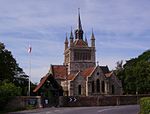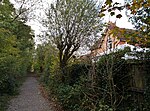Whippingham

Whippingham is a village and civil parish on the Isle of Wight. The population of the Civil Parish at the 2011 Census was 787. It is located 1+1⁄2 miles (2.4 km) south of East Cowes in the north of the Island.Whippingham is best known for its connections with Queen Victoria, especially St Mildred's Church, redesigned by Prince Albert. The village became the centre of the royal estate supporting Osborne House and Barton Manor. The farms, school, almshouses, forge and cottages were rebuilt when they became part of the Queen's estate and Prince Albert had a 'model farm' built at Barton. Queen Victoria took a close interest in 'her people' in Whippingham, providing for them in sickness and in health. It is also the home to The Folly Inn.
Excerpt from the Wikipedia article Whippingham (License: CC BY-SA 3.0, Authors, Images).Whippingham
Whippingham Road,
Geographical coordinates (GPS) Address Nearby Places Show on map
Geographical coordinates (GPS)
| Latitude | Longitude |
|---|---|
| N 50.733333333333 ° | E -1.2666666666667 ° |
Address
Whippingham Road
Whippingham Road
PO32 6NG
England, United Kingdom
Open on Google Maps







